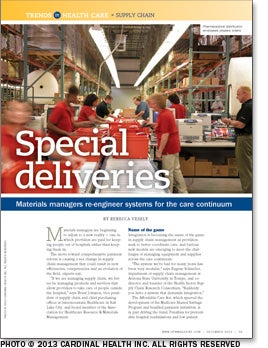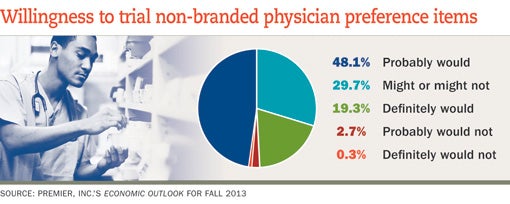Special deliveries

Materials managers are beginning to adjust to a new reality — one in which providers are paid for keeping people out of hospitals rather than keeping them in.
The move toward comprehensive payment reform is causing a sea change in supply chain management that could result in new efficiencies, competencies and an evolution of the field, experts say.
"If we are managing supply chain, we better be managing products and services that allow providers to take care of people outside the hospital," says Brent Johnson, vice president of supply chain and chief purchasing officer at Intermountain Healthcare in Salt Lake City, and board member of the Association for Healthcare Resource & Materials Management.
Name of the game
Integration is becoming the name of the game in supply chain management as providers seek to better coordinate care, and various new models are emerging to meet the challenges of managing equipment and supplies across the care continuum.
"The system we've had for many years has been very modular," says Eugene Schneller, department of supply chain management at Arizona State University in Tempe, and co-director and founder of the Health Sector Supply Chain Research Consortium. "Suddenly you have a system that demands integration."
The Affordable Care Act, which spurred the development of the Medicare Shared Savings Program and bundled payment initiatives, is in part driving the trend. Penalties for preventable hospital readmissions and low patient satisfaction scores also are spurring changes to materials management.
"When patients go home from the hospital, we want to make sure they have the same, if not equivalent supplies, materials and pharmaceuticals they require," Schneller says, so that they have better outcomes and don't require rehospitalization.
A challenge for care integration is resulting from new mergers and acquisitions around the country, as health systems seek to align with clinics and surgical centers to offer seamless care to patients in various settings. "This brings together different groups that have different purchasing systems and product formularies," Schneller says.

Innovations abound
Various systems are coming up with innovative ways to meet the challenges of the new supply chain environment, Schneller says, and it's too early to say which ones will prove most effective. Examples of this include the decision to place purchasing in a strategic position for the system, standardizing information technology platforms and developing strategies for greater physician input into supply decision-making.
Intermountain Healthcare took the unusual step of becoming a self-distributor to meet the needs of its expansive network of providers. The $40 million Kem C. Gardner Supply Chain Center opened in 2012, and handles 2.5 million medical items per year for Intermountain's 22 hospitals, 185 clinics and its medical group.
Johnson says the self-distribution model has done more than centralize supply chain management — it has resulted in a shift in thinking about the materials management. The center also handles accounts payable, inventory control and all logistics.
"The synergy has exceeded our expectations," Johnson says. "When we had to pay for every touch point, we suddenly had the passion to standardize products and reduce costs. When costs are shrouded behind a third-party supplier, they are hidden."
One example is truck delivery. As health systems expand geographies and locations to reach patients across the continuum of care, they need trucks to move supplies. Intermountain is working toward a goal of reducing truck delivery costs by 30 percent.
"Every truck that backs up to a hospital loading dock needs to be paid for," Johnson explains.
Schneller says that Intermountain is proving to be successful in self-distribution because of its focus on bringing everything under one umbrella. But he points out that not every hospital or health system has the resources or even the need for self-distribution.
Others have gone in the opposite direction of outsourcing their supply chains. For instance, the Nebraska Medical Center in Omaha in 2003 outsourced its supply chain management to Cardinal Health, Dublin, Ohio. Under this agreement, Cardinal Health oversees contract management, purchasing, distribution and inventory control.
The deal has resulted in a $2.1 million annual increase in charge captures.
Steve Inacker, president of hospital sales and services for Cardinal Health, says he expects to see more new models in supply chain management emerge with health care and payment reform.
"I think you will find people trying things they would not have previously tried," Inacker says. "We are having more of those conversations now than I can remember in my 21 years at the company."
Many organizations are seeking to standardize processes and protocols to serve patients across service lines and settings, Inacker says. "Most of our customers have done a good job of getting the best price out of products," he adds. "What we are finding is integrated delivery networks are looking at the most efficient way to move product to different care settings."
About 60 percent of hospitals keep all supplies at a hospital or central storeroom and then move those supplies to surgical centers and clinics on an as-needed basis, Inacker says. Some are now moving toward a system in which supplies and equipment are delivered directly to outpatient services or the home.
"It's the last mile in the supply chain," he says. "It's a way to reduce labor costs without touching clinical care."
In March 2013, Cardinal Health completed its acquisition of AssuraMed, a direct-to-home medical supplies distributor, for $2 billion. With this deal, Cardinal Health can reach more patients as it works across health care settings.
"It doesn't matter where the patient enters a provider network, we have the ability to service the entire continuum of care," Inacker says.
Purchasing practices
Hospital supply chain managers likewise are taking a closer look at outpatient purchasing. Einstein Healthcare Network, a large integrated system serving the Philadelphia region, in 2012 identified purchasing practices at its 50 outpatient offices.
At the time, the physician offices used many different distributors with different contracts from those on the inpatient side. The system worked with Premier Inc., Charlotte, N.C., and McKesson, San Francisco, the contracted distributor, to make sure all office locations were on the roster. Einstein Healthcare Network also made sure that manufacturers honored the same price at all locations. The result was an immediate savings of $50,000, and ongoing savings with the standardization of contract tiers and reduced paperwork, according to Premier Inc.
Johnson of Intermountain sees big changes to the supply chain in the near future. "Within 24 months we are going to see a big turnaround," he says, adding that he believes that in five years half of health care billing will be in the inpatient side, down from 80 percent of billing today.
As pressure mounts to reduce overall health care costs while improving clinical care, the supply chain is becoming more important to the C-suite, experts agree. "You are starting to see a movement of supply chain management to the executive suite," says Schneller. "Every dollar you save goes straight to the bottom line."
Transformational products
With a higher profile comes greater responsibility, he adds.
"There is a demand for suppliers to think about products that are not just incrementally better but that are transformational," Schneller says, especially with the pressure to reduce health care-associated infections and conditions, and improve patient satisfaction.
A good example, he points out, are the replacement of stainless steel surfaces with copper surfaces that have demonstrated antimicrobial value in such areas as the intensive care unit.
"We have been product-takers and not product-makers. That needs to change faster as we learn about the superiority of products through comparative effectiveness studies. Health care has been very late to this dance, but it is starting to catch on."
Rebecca Vesely is a freelance health care writer based in San Francisco.




